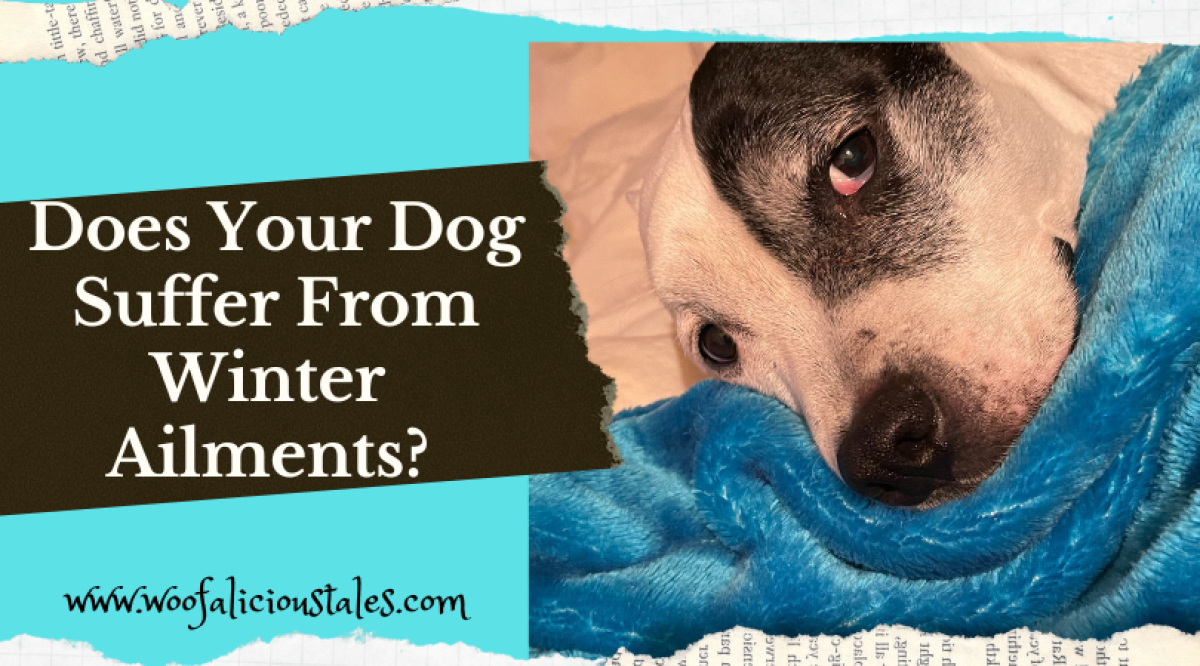Does Your Dog Suffer From Winter Aliments?

Hey Woofa’s,
Winter is definitely here.
Some days are a bit cooler than others.
I’m a person who feels the cold! I feel it in my bones and it makes it hard to warm up.
For some of us this can make it difficult for us to move around easily.
Well it can be the same for our dogs.
The cold weather can see our dogs moving around less freely.
Especially for our older dogs.
But also for our dogs that have had operations, these can be weaknesses in your dog’s body.
Cold weather together with weaknesses can see our dogs less inclined to want to move around.
What are winter ailments and how can I tell if my dog suffers from them?
WHAT ARE WINTER AILMENTS?
As stated above, winter is here and with winter comes cold weather.
For some of us cold weather can have an impact on our bodies.
Our dogs are no different in this regard.
Winter ailments your dog could suffer from are below:
1. Arthritis
Arthritis basically means sore, swollen and stiff joints within your dog.
The drop in temperature that comes with winter can generate an inflammatory response in the joints, causing the tissues to swell, which then puts pressure on the nerves.
This causing some discomfort and stiffness within your dog’s joints.
You may think this mainly occurs in our older dogs and that partly is correct.
However if your dog has had an operation on one of their joints, the cooler weather could cause pain within that joint also.
For example, Billy tore both his ACL’s (Anterior Cruciate Ligaments – in the back knee) last year. When we take him for a walk in winter, we notice a slight stiffness still within those weakened joints.
Your dog might have some difficulty getting up after laying down for some time. Or they move around a little slower, and when the area is touched they could become uncomfortable or grouchy with you.
What to do?
Keep your dog moving, albeit not harshly just enough to keep the joints moving. If it’s too cold outside play some games inside, but all the while watch their movements to make sure you’re not overdoing it.
There are also joint supplements out there that can assist in your dog’s movements, we were advised to put Billy on Green Lipped Muscle Powder and that has kept him moving. After the big walk where he has a slight limp we gave him laser treatment.
Other treatments may include joint supplements, pain medications, light exercise or physiotherapy (Canine Bowen Therapies) etc.
When in doubt, call your local trusted Veterinary for advice.
2. Skin conditions
Cooler weather can also cause our skin to dry out, and become cracked, well it’s the same for our dogs.
Being inside by the fire or heater, air-conditioning and hairdryers all have a tendency to dry our dog’s skin out. The air is generally dryer as well during winter which can cause our dog’s skin to dry out causing it to potentially become itchy and irritated.
Also some people tend to lean towards not having their dog groomed during winter as much. It’s important to keep your dog’s coat maintained during the cooler months as well.
What to do?
Make sure your dog is getting plenty of water for hydration.
You could put oils in their dinner as in Omega 3s or a bit of natural olive oil.
If there’s a small part of the skin irritated and dry Pawpaw ointment will help.
It’s also important to keep their coats groomed during winter as well.
When in doubt, call your local trusted Veterinary for advice.
3. Weight gain
It’s so easy to pile on extra kilos in winter, because we want to eat more and we move less. Again it’s the same for our dogs.
I’m guilty of not wanting to go for a walk in winter – because it’s too bloody cold!! So therefore Billy doesn’t get walked as often either. However we do run him up and down the hallway in winter!!!
While some weight gain may be okay for some of us, if we’re already carrying excess weight more weight isn’t good. Same goes for our dogs.
Extra weight in our dogs puts more strain on those already sore joints.
What to do?
Maintain your dog at a healthy body weight.
Keep exercising them indoors if you have to.
Monitor what they’re eating.
Weight them at your local pet store or vets and keep an eye on it.
4. Kennel Cough
Kennel cough in dogs sounds like a dry heaving honking cough. It can strike any time of year but the cooler weather doesn’t help.
Kennel cough got it’s name because most dogs that got boarded in kennels at vets, or anywhere where dogs congregate for a long period of time.
However I learnt that this is not always the case when Isabel got kennel cough and she hadn’t left our yard!!!!!
I was surprised and a bit peed off to be honest because my vet had vaccinated her for it, she hadn’t been out walking nor had she been to any kennels, or mixed with any other dogs other than Billy.
The Vet told me because she was older (she was 13 at the time) regardless of whether she was vaccinated she was still susceptible to getting it.
I asked him if I had to separate Billy from her and he said no because he was 1 year he was young, vaccinated and wouldn’t get it and he never did.
I also asked how she got it when she hadn’t been anywhere. He mentioned that a dog with it could cough in the air and it’s traveled and because she’s older she caught it.
With a bought of anit-biotics to ease her symptoms she got over it within a week, but that cough sounds terrible.
It’s said that a mild case your dog will get over it within a week without anything but I wasn’t happy with that, so took her to the vet anyway.
What to do?
Seek advice from your trusted Veterinarian.
5. Doggy sniffles, flu and pneumonia
If your dog has the sniffles you will notice things such as a runny nose, slight cough (not kennel cough) or tiredness.
However, doggy flu is a general term for a highly contagious upper respiratory disease that can affect your dog.
Doggy pneumonia is where there is inflammation of your dog’s lungs.
The most common symptoms of flu and pneumonia include sneezing, runny nose, dry or moist cough, watery eyes, loss of appetite, and fever.
What to do?
You could try feeding your dog a bland diet, boiled chicken breast with rice, it may help with the congestion.
OR try a humidifier.
However if your pet has trouble breathing and doesn’t eat or drink, seek advice from your trusted Veterinary asap.
6. Difficulty Regulating Body Temperature in Sick or Elderly Dogs
Cold weather can cause your dog to have a low body temperature.
This can affect your dog’s bodily functions in many ways, and older dogs and those with kidney problems, cushing’s disease, or hormonal issues can have a harder time regulating their body temperature.
A low body temp can affect how well their heart works, cause an irregular heartbeat, and bring about low oxygen in the body or a change in blood pressure.
It can suppress the immune system, leading to a higher infection rate and slower wound healing.
Cold can also affect the gastrointestinal system, slowing down digestion as well as making it harder for the liver to metabolize medications.
So it’s important to keep your dogs warm and indoors during the colder parts of the day and night.
What to do?
Keep your dog inside. Make sure they have a warm, dry bed with blankets to keep them warm.
Our dogs feel the cold as well.
If you walk your dog regardless of the temperature, at the beginning of the walk and if your dog will wear one, put a jumper on them.
Keep checking though as they warm up you may want to remove the jumper. We don’t want them to overheat.
Again when in doubt contact your local trusted Veterinarian for advice.
7. Hypothermia
Our dogs feel the cold as well.
Hypothermia can occur in your dog if their body temperature drops too low for a long period of time.
Symptoms may include – shallow breathing, shivering, lethargy, really stiff muscles, pale skin and your dog barley moving.
Severe hypothermia can also result in a slow heart rate, stiff muscles, and a failure to respond to stimuli.
I’d like to think here in Australia this doesn’t occur, but we do have areas where it snows.
Dogs who already suffer from heart ailments and diabetes are at an increased risk of hypothermia during the cold months.
What to do?
The normal temperature for a dog should not go below 100.5°F.
If you see these symptoms in a dog (or any pet) near you take them to the nearest Veterinary asap.
If the temperature is below 95°F, wrap the animal in blankets and take them to the Vet.
WHAT DOES ALL THIS MEAN?
With winter comes the cold weather.
We feel the cold and so do our dogs.
Keep an eye on your dog to make sure they are not suffering from any of the above ailments.
When in doubt, call your trusted Veterinary for advice.
IN THE COMMENTS BELOW – BILLY WOULD LIKE TO KNOW– IF YOUR DOG HAS ANY WINTER AILMENTS AND HOW YOU LOOK AFTER THEM?

Related Posts
How To Make Sure Your Dog Is Warm and Snuggly This Winter!
Hey Woofa’s, This morning we woke to a 13 degree day with rain…
10 July 2023How To Keep Your Dog Happy This Winter!
Hey Woofa’s, I can’t ignore it any longer Winter is almost…
10 July 2023



Leave A Comment